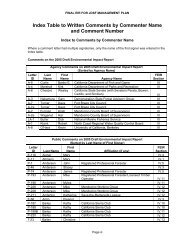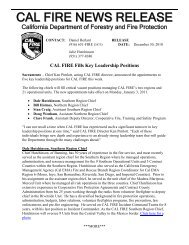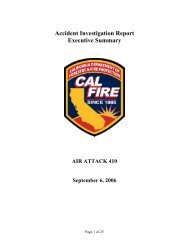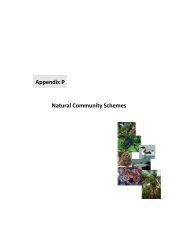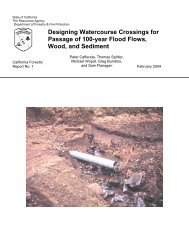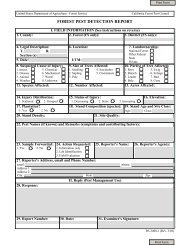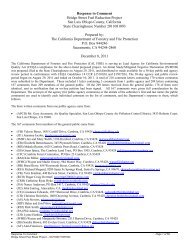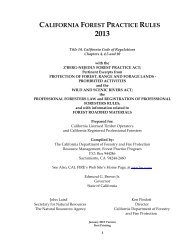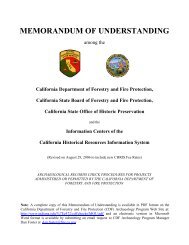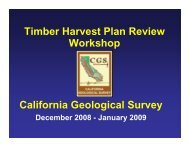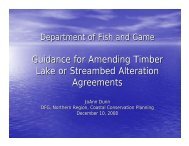Boggs Mountain Demonstration State Forest Draft ... - Cal Fire
Boggs Mountain Demonstration State Forest Draft ... - Cal Fire
Boggs Mountain Demonstration State Forest Draft ... - Cal Fire
Create successful ePaper yourself
Turn your PDF publications into a flip-book with our unique Google optimized e-Paper software.
<strong>Boggs</strong> <strong>Mountain</strong> <strong>Demonstration</strong> <strong>State</strong> <strong>Forest</strong> <strong>Draft</strong> Management Plan, June 2008<br />
Chapter 4. Research and <strong>Demonstration</strong><br />
The primary purpose of <strong>State</strong> <strong>Forest</strong>s is to research and demonstrate economical silvicultural<br />
practices and timber harvesting procedures that protect environmental values. Long-term studies<br />
are crucial to understanding the effects of forest management actions as well as the effects of<br />
broader changes in forest influences, such as global climate change. As a publicly-owned forest<br />
dedicated to research and demonstration, BMDSF provides an ideal venue for long-term<br />
research. Some research projects on BMDSF have been periodically monitored for decades.<br />
Ecologists used to focus on seral stages: pioneer through climax conditions. Once reaching a<br />
climax condition it was thought that stands of trees would always proceed in a steady-state small<br />
scale disturbance regime. This concept is now considered the exception for most ecosystems,<br />
with disturbance being the rule rather than the exception (Botkin 2006). The challenge now is to<br />
understand the disturbance regimes of the past and future to provide a productive outdoor<br />
laboratory for researchers. BMDSF’s management plan, with its mix of older and young forest<br />
structure goals, and utilization of a variety of unevenaged and evenaged silviculture techniques,<br />
is well suited for such studies.<br />
<strong>Forest</strong> stands at <strong>Boggs</strong> <strong>Mountain</strong>, if left unmanaged, are capable of growing to very dense, highly<br />
overstocked conditions. The primary risk of maintaining such dense stands is a greatly increased<br />
risk of wildfire. The growth and health of such overstocked stands is also greatly inhibited.<br />
Because access into, and travel through very dense stands becomes difficult, recreation is<br />
negatively affected. The important research questions facing <strong>Boggs</strong> <strong>Mountain</strong> can be posed as<br />
follows: how does forest management influence<br />
• <strong>Forest</strong> health and productivity<br />
• Growth and yield<br />
• <strong>Fire</strong> hazard such as fuel loads<br />
• <strong>Forest</strong> resiliency to wildfire<br />
• Wildlife habitat dynamics<br />
• The wildland-urban interface<br />
• Climate change and carbon sequestration potential of the <strong>Forest</strong><br />
Research Program Objectives<br />
1. All ongoing studies should be carried out to completion. Final reports will be written on<br />
these studies. Reports should be in the form of a <strong>Cal</strong>ifornia <strong>Forest</strong>ry Note whenever<br />
possible. Technical reports should be published in other journals when significant results<br />
are found. Follow up with researchers to ensure publication of results.<br />
2. Encourage the permanent staff to be alert for potential studies and initiate studies<br />
whenever possible. Seek advice from research institutions and forest managers on<br />
potential studies that could be conducted.<br />
3. Continue to utilize research funds and leverage professional contacts, <strong>Forest</strong> data,<br />
infrastructure (housing) and assistance with labor to encourage researchers to conduct<br />
their research on BMDSF.<br />
4. Give tours to groups or individuals to show projects being conducted.<br />
41



